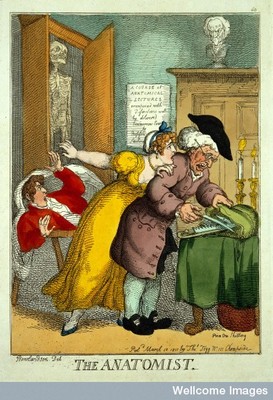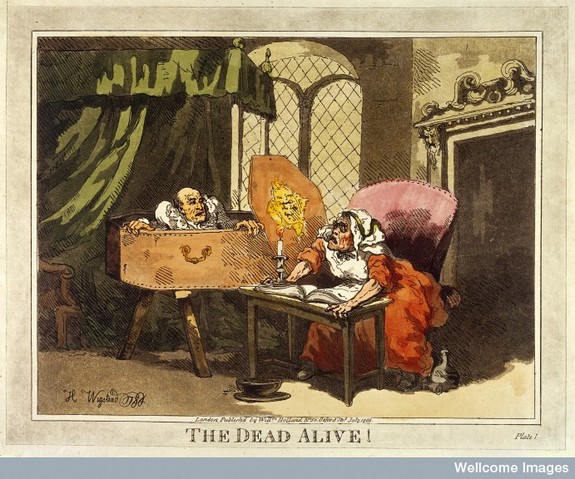On Sunday, The Post Standard reported a story that could have come straight from the script of a horror movie. In October 2009, Colleen S. Burns was admitted to St Joseph's Hospital Center in New York for a drug overdose. A short time later, a team of doctors pronounced the 39-year-old woman dead. Her family was notified and Burns's body was prepped for organ donation.
The only problem was: Burns wasn't actually dead. She was in a drug-induced coma. Fortunately for her, she woke minutes before the first incision was made.
Happily, occurrences such as this are few and far between these days. Yet in the past, incidences of premature dissection were not uncommon.
In 1746, Jacques-Bénigne Winslow wrote: "Tho' Death, at some Time or other, is the necessary and unavoidable Portion of Human Nature in its present Condition, yet it is not always certain, that Persons taken for dead are really and irretrievably deprived of Life." Indeed, the Danish anatomist went on to claim that it was "evident from Experience" that those thought to be dead have proven otherwise "by rising from their Shrowds [sic], their Coffins, and even from their Graves."
Fears over premature burial were ubiquitous during this period, so much so that people created 'life preserving' coffins with bells and breathing tubes attached. But even worse than being buried alive was the thought of being dissected alive. The threat was real, and it happened often enough to be commented on in contemporary literature with some frequency.
The 17th and 18th centuries were rife with stories about executed criminals who had 'returned from the dead' just moments before being dissected. In 1651, Anne Greene was hanged in Oxford for infanticide. For thirty minutes, she dangled at the end of the noose while her friends' thump[ed] her breast' and put 'their weight upon her leggs [sic]...lifting her up and then pulling her downe againe with a suddain jerke' in order to quicken her death. Afterwards, her body was cut down from the gallows and brought to Drs Thomas Willis and William Petty to be dissected. Just seconds before Willis plunged the knife into her sternum, Anne miraculously awoke.
The 19th century had its fair share of incidences too. The physician and surgeon, Sir Robert Christison, complained that dissection in St Bartholomew's Hospital in London was 'apt to be performed with indecent, sometimes with dangerous haste' during this period. He remembered:
...an occasion when [William] Cullen commenced the dissection of a man who died on hour before, and when fluid blood gushed in abundance from the first incision through the skin...Instantly I seized his wrist in great alarm, and arrested his progress; nor was I easily persuaded to let him go on, when I saw the blood coagulate on the table exactly like living blood.
He further remarked: "It was no uncommon occurrence that, when the operator proceeded with his work, the body was sensibly warm, the limbs not yet rigid, the blood in the great vessels fluid and coagulable [sic]."
The problem wasn't contained to Britain alone. The French physician -- Pierre Charles Alexandre Louis -- reported the story of a patient who had been placed in his dissection room at the Pitié-Salpêtrière Hospital in Paris. The next morning, the doctor's colleagues informed him that they had heard moans in the locked theater overnight. When Louis went to check it out, he found 'to his horror that the supposed corpse had revived during the night, and had actually died in the struggle to disengage herself from the winding sheet in which she was enveloped'.
 It was largely because of reports like this that anatomists, themselves, worried about the precise moment of death when cutting open bodies. To avoid disaster, good old Winslow suggested that a person's gums be rubbed with caustic substances, and that the body be "stimulate[d]...with Whips and Nettles" before being dissected.
It was largely because of reports like this that anatomists, themselves, worried about the precise moment of death when cutting open bodies. To avoid disaster, good old Winslow suggested that a person's gums be rubbed with caustic substances, and that the body be "stimulate[d]...with Whips and Nettles" before being dissected.
Furthermore, the anatomist should "irritate his Intestines by Means of Clysters and Injections of Air or Smoke" as well as "agitate... the Limbs by violent Extensions and Inflexions." If possible, an attempt should also be made to "shock [the person's] Ears by hideous Shrieks and excessive Noises."
To our modern sensibilities, these measures may seem extreme, even comical, but to Winslow, this was no laughing matter. In fact, he went even further, recommending that the palms of the hands and the soles of the feet be pricked with needles, and that the 'Scapulae, Shoulders and Arms' be scarified using fire or sharp instruments so as to 'lacerate and strip [them] of the epidermis." Indeed, when reading Winslow's work, one gets the innate feeling that he took pleasure in imaging new ways to torture the dead.
Today, new debates have arisen over the very definition of death itself with the emergence of "beating heart cadavers." Though considered dead in both a medical and legal capacity, these "cadavers" are kept on ventilators for organ and tissue transplantation. Their hearts beat; they expel waste; they have the ability to heal themselves of infection; they can even carry a fetus to term. Crucially, though, their brains are no longer functioning. It is in this way that the medical community has redefined death in the 21st century.
Yet, some wonder whether these "beating heart cadavers" are really dead, or whether they are just straddling the great divide between life and death before the finally lights go out.
Or, worse, have been misdiagnosed, as in the case of Colleen Burns.
For more medical history tales, check out The Chirurgeon's Apprentice.
